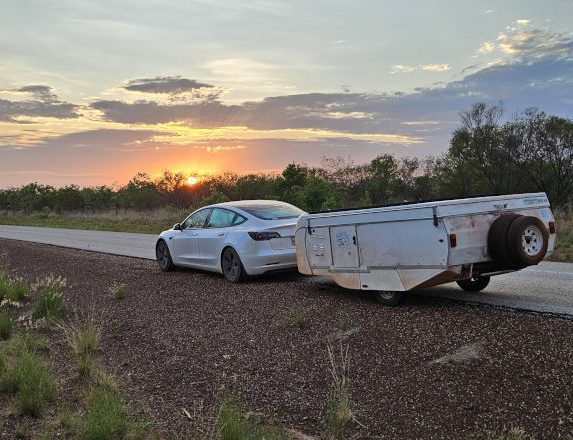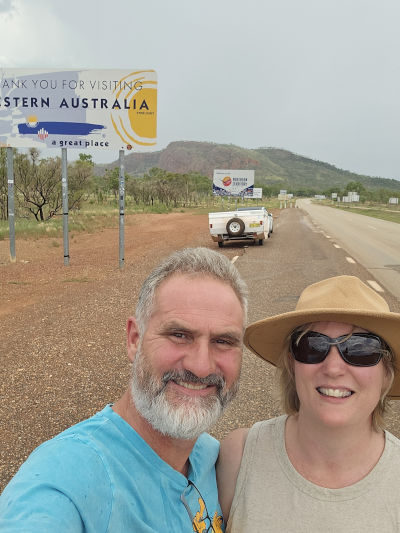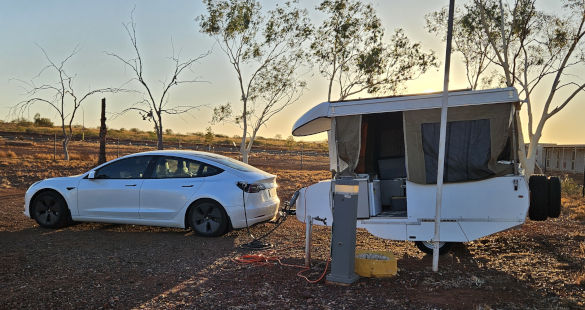While the debate about whether an electric vehicle will ever be able to tow a caravan around Australia continues to rage, a couple from WA are seeking to settle the argument … by actually doing it!
Sarah White and Shane Parker, who are in their mid 40s, set off from Perth on Boxing Day in a 2021 standard-range Model 3 Tesla towing a modified 1986 Cub Drifter.
So far, they’ve travelled via Broome, Derby, Katherine, Darwin, Daly Waters, Threeways, Mt Isa, Charters Towers and Townsville to the east coast, before heading south and they have currently got as far as Sydney. They’re next heading to Canberra, Melbourne, Adelaide, and Port Lincoln before heading across the Nullarbor and home to Perth.
And the verdict … it’s definitely do-able!

'Is that a Tesla towing a van!'
Their Model 3 Tesla can generally do about 400 kilometres around town or about 350 kilometres on the highway.
“When towing the van we can adjust our range by adjusting our speed, and even the time of day that we drive,” said Sarah. “At 80km/h, we can go more than 220 kilometres without a top-up and, if it is early in the day, so the air conditioning is not working too hard, we can stretch that to 240km or more.”
She says that, at 100km/h, they can usually get a range of at least 180 kilometres, even with a headwind.

Trailblazers … Shane and Sarah are showing what can be done.
On the east coast, Sarah says fast charging stations are usually less than 100km apart, so there are no problems.
It’s a different story, of course, in the Outback but Sarah says you can actually charge an electric car from anywhere you can plug in an electric kettle.
“There is a little bit of planning required when we are charging off regular power points, in that if that is all there is available then we try and plan to sleep at that location for the night,” she said.
The couple’s secret weapon is the van itself.
Having bought their Cub Drifter second-hand, they stripped it down and re-built it with light-weight components so they could add solar panels, batteries, an air-conditioner and a King-sized bed!
“When totally off grid, the van is capable of adding about 1/3 of a charge to the car at 5kW, and, when in a caravan park, it can charge the car at 7.4kW, which is plenty to give us a full charge for the next morning,” Sarah said. “The caravan can be charged from a caravan park or the solar panels on the roof, meaning the batteries are essentially a self-re-filling jerrycan which tops itself up as we drive along!”
So far, their longest leg without charging from a power point has been 287 kilometres from Sandfire Roadhouse to Roebuck Plains Roadhouse, which they made without trouble after stopping at a free camp to top up the car from the van.
“The leg from Fitzroy Crossing to Halls Creek was also 287 kilometres, but is up a 330m elevation change and it had no alternative charging options along the way,” said Sarah. “But having proved that we could do it on the drive into Roebuck Plains, we were not worried and sat in the air conditioning in the caravan while we topped up the car from the van about 50 kilometres out of Halls Creek.”
Sarah and Shane are excited at how quickly fast charging infrastructure is being built, even in remote areas.
“WA’s fast charging network is three-quarters built and will be similar by mid-2024,” said Sarah. “We understand the South Australian network is progressing and look forward to seeing the improvements from last year.”

Wherever you can boil a kettle, you can charge an EV.
The couple says that, while the NT seems to be lagging a bit, they have come across some sites where construction has started there, too … so the Territory may catch up pretty quickly.
“As electric vehicle uptake increases, the charge network will need to keep up, just as more service stations needed to be built when petrol powered motoring became more commonplace,” said Sarah. “In the same way as people didn’t stand for having unsealed roads and poor fuel supplies across the Nullarbor, they won’t stand for a lack of EV charging infrastructure.”
The couple estimate that, within the next 12-18 months, EV road trippers will find charging can be done around the country with a similar amount of planning to anyone travelling long distances in any vehicle.
At the moment though, an EV towing a caravan is still very much a novelty in the Outback … and the couple’s electric rig has sparked much interest in places like Barkly Homestead and Daly Waters.
“We have frequently been met with what we like to call ‘the look’, which is when people clock the type of vehicle, then the caravan, then do a double take as they realise,” said Sarah. “We’ve also overheard a few amusing comments over the two-way … one in WA just outside Geraldton on day one of our trip where a guy was overheard saying to his mate ‘they shouldn’t even be out here’, and another near Mt Isa in Queensland where a bloke in a Ute said to his mate ‘that was that a ****ing Tesla’!!”
Shane and Sarah say that, with an EV, typical commuting consumption is about 15kWh/100kms but the cost very much depends on how and where you charge it. It can vary from free (often shopping centres, cafes, pubs etc will have free charging) to 7c/kWh off home solar (around $1/100km), to about 20c/kWh on an overnight off peak (around $3/100km). When road tripping, the pair generally use fast chargers that typically cost about 60c/kWh (so around $9/100km).
As well as being cheaper to travel in, the couple has also found electric vehicles much quieter, and that changes the Big Lap experience for the better.
“We have definitely noticed that animals react differently as we approach, particularly kangaroos, cows and eagles,” said Sarah. “They tend to notice you as you are passing rather than as you approach when they usually get scared and jump in your way … by the time they realise we’re there, we’ve passed them and they go right on munching.”
Having already dipped their toes in the EV Big Lap waters, as far as Shane and Sarah concerned, the future is very much electric.
“Large 4WD EVs capable of towing big caravans are available in other countries but not in Australia yet,” Sarah said. “As soon as they become available, I can’t see why grey nomads won’t start using them.”
GNT readers can follow Shane and Sarah’s EV adventure here:
Are you a Grey Nomad member yet? Click here to find out about the discounts, competitions and other benefits on offer.
Can’t honestly believe that anyone would take this seriously! A specifically modified ultralight caravan and an actual range towing of a few hundred kilometres.
How could this even remotely, possibly be done with a typical van, and the associated basic comforts.
May as well ditch the van and use a light weight tent and a set of folding solar panels.
This article is real. It’s not Ai. Sarah has a bad back and needs a good bed. She travels in style. Aircon and super cheap to run. What a strange comment to make!
And the verdict … it’s definitely do-able!
Yeah! by towing a solar powered battery on a trailer to do 200klm/day.
Sorry it would be better to use a Camel cart, may as well dress up in 18th Century clothes for the journey – at least you could entertain the country folk whilst meandering around Australia.
They said 200 km a charge. Not 200 km a day. In places with fast charging infrastructure they could easily do 600 or 800 km a day.
But is that really the point? Do people really start on a trip around Australia and aim to complete it as quickly as possible? Most of the time you will hang out in one spot for a couple of days and then which you feel like moving on, you will head a bit further up the road.
Sarah and Shane are getting on and making things happen, not complaining that it can’t be done.
Met a couple who have ridden pushbikes around Australia which sounded more interesting and less stressful to me. Before following Shane and Sarah’s lead I would suggest a little research would be a good idea. EV’s have their place and that is in warehousing where Battery Powered materials handling vehicles have been successfully used for well over 100 years. Grow up people before it’s too late. People double down on their own mistakes to make themselves feel better and to protect the value of their bad investment. There are plenty of bad/disasterous stories about EV automobiles and Liion Batteries- but that is all ‘misinformation’.
OMG the amount of FUD here is disturbing.
There are hardly any EV fires (and 90%of those are from Hybrids), especially compared to ICE fires. Do your research!
I guess it depends where you research and what will satisfy preconceptions. In 1966 I and 2 mates took an EH ex taxi Holden up Cape York Peninsular via the telegraph track. We were young and adventurous auto engineers. We had rifles, food, shovels, ropes, pulley blocks and not much else. Would I call that a vehicle fit for purpose? NO. Does that fit with your FUD label? NO. I have also had a 520ah Li-ion battery almost cause the loss of our beautiful motorhome. Something tells me you are shooting from the hip by comparison. EV lithium battery fires have caused the sinking of at least two ships (research tells me) in which almost 8000 vehicles went to the ocean floor and with loss of human life in recent months. House fires due to Li-ion batteries are now very common! ICE vehicle fires, by comparison are easily extinguished, and are seldom a problem for surroundings. You conveniently forget to mention the gzillions of ICE vehicles in our world compared to a few EV’s.
And yet I’m happy that you express your opinion. It just won’t change mine.
Just a few points:
While you are correct that older chemistry lithium batteries can ignite under certain circumstances, there is almost no equivalency between small cheap batteries with poorly regulated or unregulated charging, and the very high quality design and manufacture of electric vehicle batteries. To directly compare them is either ignorance or deliberate misdirection.
Here’s why, very simple version.
Modern EV batteries are different chemistry from portable, power tool, e scooter, gopher batteries, are built to much higher standards, and are very regulated in both charging and use. That chemistry is evolving, and a new wave of Sodium ion batteries are already commencing large scale production.
Are the stories and images of EV battery fires of many events, or the same few events on endless repetition?
Having been around a couple, I’m amused yet saddened by your claim that ICE fires are “easily extinguished”.
As you said, I’m not going to be able to change your mind, but perhaps other readers may give pause to wonder…..
Go well.
Interesting article, Next long distance travellers will all be limited to a baby van as a charging source to be towed everywhere, never mind your creature comforts. I can’t see electric vehicles taking of with towing vans at such a short distance in this vast country, until there are more efficient ways of charging these cars and other vehicles right now.We don’t have sufficient infrastructure to allow for swift charging fill ups , furthermore the country travel that will allow the average nomad that 300 to 500 kms per day presently easily done on fossil fuels. I’m told by various articles is the norm. The fact these people have changed their van to accommodate the vehicles capacity to tow and charge says it all. At present it’s really an uneconomical experiment for the purpose of making it work.
With an average sized van behind, teslas actual towing capacity would not allow for the vast majority of caravans on the road today. May be in a few more decades electric vehicles might reach standards that will be on a par of the average petrol/ diesel motor vehicle presently available. I can’t see it being successful right now. It’s like we are at the trial and error stage , being part of an experiment that seems risky at most … Australia has some very unforgiving country out there and not having the correct infrastructure in place before introducing these vehicles is both bizarre and irresponsible of our government today. We are being used as Guinea pigs in a world wide experiment that is bound for the scrap heap before its even reached its infancy. Sudden Fires and battery charges/ replacements required to fuel these electric guzzlers seems ludicrous. Peoples lives are at stake.
No thanks, reliable travel is paramount in Australia and electric cars on long distance routes is ridiculous. Truckers using fossil fuel even find themselves tested at the best of times. Don’t be party to the revolution of gullibility, what happens in 50 years time, too late she/he cried.
I would compare the fuel/electricity costs (towing the same sort of caravan), before you say it’s uneconomical. Don’t forget…. road trips are an exception. Most of the rest of the time, EV’s are charged at home, for free (or very nearly) via Solar.
Again, FUD. Fires are WAY more common in ICE (check the stats) vs EV (and most of those battery fires are from Hybrids and cheap scooters).
6.5 V8 grunt for me..!
I’ll leave all the EV stuff for future generations..!!!
From the Royal Automobile Club Of Victoria’s website.
Volunteers in The Tesla Owners Club did the engineering reports and paid for the accreditation of the tow equipment in Australia. It is legal to tow.
Jeepers, there are a lot of naysayers on this blog! You would be happy to go back to candles and kero fridges! The future is here now. I certainly hope to be traveling in a EV when I’m a grey nomad.
Just a hint:
Please don’t say “research” unless you do mean peer reviewed rigorous repeatable evidence-based process.
Inquiry, investigation, search, look, even “ah ha I’ve found a post that matches my belief” are more accurate, more honest, less deceiving.
YOU ARE NOT DOING RESEARCH WHEN YOU LOOK AROUND ON THE INTERNET.
There, rant done, for now….
So, you are saying is get your research where? University students? Go ahead and stick your toe in the water and put your money on it. Just don’t suggest to all of us that only you know and your answer is the correct one. Believe it or not experience is a valuable teacher. Just remember our world is paying a very heavy price for this experiment. Governments have no idea because they are guided by wishful thinkers.
I have detailed my experience on this subject and I hope there are some who value that experience.
It seems to me that my grandfather would have heard many of the comments above about how the horseless carriage would never replace horses. It is early days. Sarah and Shane have shown a new way of doing the lap around Oz. Yes, they have a specially modified small van. Yes, they have limited range, but they are doing it and are pioneers to be congratulated. New battery technologies are being produced with higher energy density and safer chemistry. Chargers are being rapidly installed across the country. It is not perfect yet, but the present batch of BEVs are excellent vehicles in the urban areas and I hope to see, in the time I have left, long range BEVs that rival the diesel tug that I now use for towing my van.